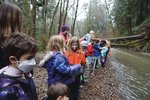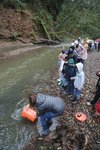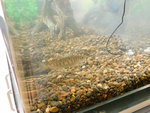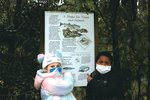



About 30 second grade students from Union Ridge Elementary School gathered along the rocky banks of Gee Creek in Ridgefield’s Abrams Park as a group of salmon fingerlings were released into the flowing water before winter break started.
The kids from Corrina Hollister and Ellen Ferrin’s classes had cared for the fingerlings for several weeks as part of the Salmon in the Classroom project, stated a news release. The tanks the fingerlings once called home were primed for the arrival of 250 new salmon eggs which will be delivered sometime this month.
Students will watch those eggs hatch, grow into baby fry and then become fingerlings before they are released on another trip to Gee Creek.
The Salmon in the Classroom program is administered by Columbia Springs and funded by Clark Public Utilities. The program provides fish tanks to schools across Clark County for a hands-on environmental education.
Kim Stenbak’s fourth grade class at Union Ridge also features a fish tank through the program.
“Her students visited Gee Creek to test the water quality before the fingerling release. They took water samples from four spots throughout the park, then returned to class to test the samples,” stated the release. “The students compared data to determine the optimal spot for release, giving the salmon fingerlings a greater chance of survival.”
Typically only one fish tank is approved per school but Stenbak applied to the program last year when the pandemic kept the students from the classroom as remote learning took place.
Because of this, Union Ridge has the opportunity to have a salmon tank in each of its two buildings. The tanks are placed in the hallway so all of the students can watch the salmon grow.
Hollister, Ferrin and Stenbak have used salmon as a theme across multiple subjects beyond science class.
Fourth grade students drew salmon pictures while second grade students learned about the salmon’s place in Native American culture by reading books.
“The multi-subject approach gives students a strong sense of salmon’s importance to the Pacific Northwest’s history, ecosystem and culture,” stated the release.
Salmon typically lay 5,000 eggs but only two or three survive to adulthood. Last summer’s heat wave increased water temperatures to unlivable levels for the salmon in the Columbia River, stated the release.
“It makes the message of climate change real,” Hollister stated in the release. “We need to let these kids know it’s our job to care for the environment, all of us.”